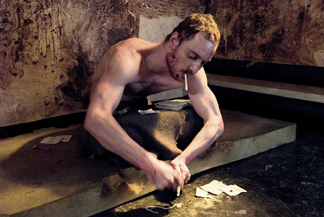Movie vs Reality: Hunger
By Felix Quinonez Jr.
October 29, 2012
The prisoners get visits from family members and we see them passing messages and smuggling in items through various methods. The prison officers take it upon themselves to make the lives of the prisoners intolerable by being violent. The prisoners are removed from their cells often to receive beatings. The prisoners grew long hair and beards as part of earlier protest and the guards physically restrain them to cut their hair. The prisoners are also held down in tubs to be violently cleaned.
One of the major concessions the prisoners were fighting for was the right not to have to wear prison uniforms. They wanted to wear their own clothes and at one point it seemed like they would get this wish. We see the prisoners led out of their cells to receive civilian clothing. But instead of giving the prisoners their own clothing, the guards distributed officially issued civilian clothing. The prisoners responded by tearing up the clothes they received and wrecking their cells.
On March 1, Bobby Sands, the IRA's former Officer Commanding in prison refused food and the second hunger strike began. They decided to do things differently this time by having prisoners join one at a time. Each would start two weeks after the previous one. They did this to gain more public support and in hopes to drag out the strike as long as possible. They also wanted to put the maximum amount of pressure on the Prime Minister Margaret Thatcher.
The movie is very explicit about Sand's deterioration in health. He died on May 5, 1981. Over 100,000 people lined the route to his funeral, which was done with full military honors.
What the Movie (may have) Gotten Wrong
Since most of the movie takes place inside the prison, it's hard to know how much of it is really accurate. The general information can be confirmed. But because the movie gets so specific about what happens, at least some of it had to be speculation. At the beginning we get to see one of the guards at various points of his day. We see so much of his routine and the way he behaves towards other guards that it is hard to believe all of those details were documented.
At one point, we see the prisoners get visits from their families. While it is more than reasonable to believe some goods were snuck in during those visits, it also seems likely that some liberties were taken for dramatic effect.
Verdict
Hunger is a very powerful movie and includes a great - and overlooked - performance from Fassbender. It portrays a very difficult story and it is understandably hard to watch. But one should know that the movie is more interested in showing the horrible conditions these prisoners had to live with than being a history lesson. And although the movie is still very moving, the fact that so much of the context is left out lessens the impact at some points. For instance, the scene in which the prisoners destroy their rooms because they didn't like the clothes they were given can - without context - be seen as a temper tantrum instead of as the important turning point that it was. But the movie is still haunting and gripping. It opens your eyes to a very tragic conflict and comments on the terrible things we're capable of doing to one another.
Next Time: Snowstorm
Continued:
1
2
|
|
|
|




